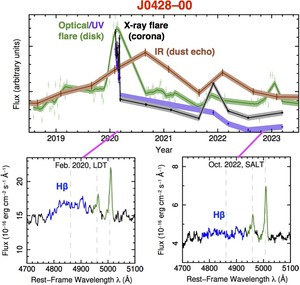
At the center of every galaxy lies a supermassive black hole, one million to a billion times the mass of our Sun. In some galaxies, gas accretes onto the black hole, persistently emitting light across the electromagnetic spectrum, creating an "active galactic nucleus" (AGN). Gas does not always accrete at a steady rate, however: recent years have seen the discovery of "changing-state AGN", which display sudden, extreme variations in accretion rate. Studying such events provides insight into how matter accreting onto the black hole reacts and organizes itself during these events, allowing us to learn how quickly or slowly supermassive blacks holes can grow over time. Such events occur very rarely on an per-object basis, but fortunately, small numbers can be amplified by monitoring as large a starting sample as possible.
From December 2019 to February 2022, the eROSITA X-ray telescope aboard Spectrum Roentgen/Gamma conducted multiple complete scans of the entire sky every six months, monitoring roughly one million AGN. In the articles "An X-ray flaring event and a variable soft X-ray excess in the Seyfert LCRS B040659.9–385922 as detected with eROSITA" by S. Krishnan et al. and "Multiwavelength study of extreme variability in LEDA 1154204: A changing-look event in a type 1.9 Seyfert" by T. Saha et al., a team of astronomers (including astronomers from Warsaw Copernicus Astronomical Center - Alex Markowitz and his former students S. Krishnan and S. Saha as well as an astronomer from the University Astronomical Observatory, Mariusz Gromadzki) reported on detections of extreme X-ray flux variations in two AGN (hereafter J0408-38 and J0428-00, respectively).
In both cases, eROSITA caught an increase, then decrease, in X-ray flux over timescales of six months in (with major variations in optical flux J0428-00 additionally reported by collaborators using GAIA). As soon as the team detected these X-ray "flares" in-progress in each AGN, they initiated multi-year followup campaigns using a range of multi-wavelength facilities to track the multiple components of gas accreting onto the supermassive black holes.
In both cases, the origin of the flaring was consistent with originating in the accretion disk that feeds the black hole; a strong candidate for the underlying mechanism is a localized radiation-pressure instability in the disk. In each case, the instability causes a sudden, but temporary, rush of new accreting gas inward towards the black hole. This rush triggered major increases in the optical/ultraviolet luminosity emanating from the inner regions of each disk, a few light-days from the black hole. These increases were observed with GAIA, NASA's Swift UltraViolet Optical Telescope, XMM-Newton's Optical Monitor, and/or ATLAS.
Subsequently, a fraction of this optical/ultraviolet emission entered the ultra-hot "corona", located light-hours from the black hole; it converts optical/ultraviolet photons to X-ray photons, thus causing the X-ray flaring initially observed with eROSITA, and later followed
up with Swift's X-ray Telescope and with XMM-Newton.
In addition, the team used ground-based optical spectroscopic facilities including the W. M. Keck telescope, the South African Large Telescope, and the South African Astronomical Observatory 1.8-meter telescope to track the optical spectra emission lines emanating from the so-called Broad Line Region of gas above the disk, several light-weeks from the black hole. These emission lines responded to the flaring in the ultraviolet band, with J0428-00 showing major evolution in its H-beta line, and J0408-38's He II line responding similarly.
Finally, in J0428-00, the flaring photons illuminated circumnuclear warm dust located roughly a light-year from the central engine. This dust emitted infrared light in the form of a "light echo" that was observed using the NEOWISE mission.
These observations into short-term, temporary bursts of accretion have helped us learn about the diversity of behaviors that AGN can undergo as their black holes grow over time.
J0408-38 and J0428-00 are located 790 million and 925 million light-years away, respectively, both in the constellation Eridanus.

Figures:
Light curves of J0408-38 (left) and J0428-00 (right), showing the optical/UV flares from the disk (green and purple), the X-ray flaring from the corona (black), and the subsequent IR echo from circumnuclear dust (brown). Optical spectra taken near each flare peak show strong helium II and/or H-beta line emission from the Broad Line Region, but
in both cases, the line emission faded over time.
Acknowledgements: eROSITA/SRG; SALT, Keck; NEOWISE
Text by A. Markowitz; Figures by T. Saha and S. Krishnan






